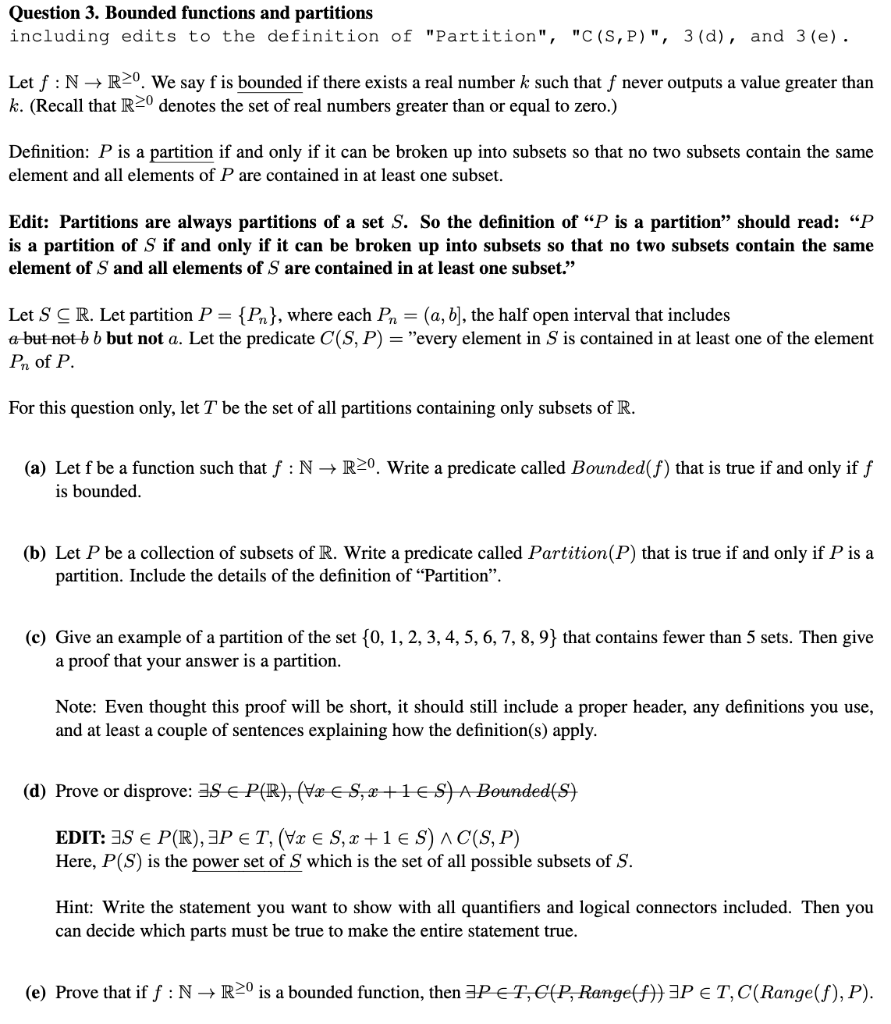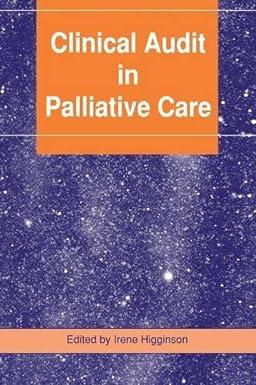
Question 3. Bounded functions and partitions including edits to the definition of "Partition", "C(S,P)", 3(d), and 3(e). Let f:N + R0. We say f is bounded if there exists a real number k such that f never outputs a value greater than k. (Recall that R denotes the set of real numbers greater than or equal to zero.) Definition: P is a partition if and only if it can be broken up into subsets so that no two subsets contain the same element and all elements of P are contained in at least one subset. Edit: Partitions are always partitions of a set S. So the definition of P is a partition should read: "P is a partition of S if and only if it can be broken up into subsets so that no two subsets contain the same element of S and all elements of S are contained in at least one subset." Let S CR. Let partition P = {Pn}, where each Pn = (a, b), the half open interval that includes a but not b b but not a. Let the predicate C(S,P) = "every element in S is contained in at least one of the element Pn of P. For this question only, let T be the set of all partitions containing only subsets of R. (a) Let f be a function such that f:N + R20. Write a predicate called Bounded( f) that is true if and only if f is bounded. (b) Let P be a collection of subsets of R. Write a predicate called Partition(P) that is true if and only if P is a partition. Include the details of the definition of Partition". (c) Give an example of a partition of the set {0, 1, 2, 3, 4, 5, 6, 7, 8, 9} that contains fewer than 5 sets. Then give a proof that your answer is a partition. Note: Even thought this proof will be short, it should still include a proper header, any definitions you use, and at least a couple of sentences explaining how the definition(s) apply. (d) Prove or disprove: 35 P(R), (+2 S,&+1 S) A Bounded(S) EDIT: 3S P(R), 3P ET, (Hx S, x +1 S) C(S,P) Here, P(S) is the power set of S which is the set of all possible subsets of S. Hint: Write the statement you want to show with all quantifiers and logical connectors included. Then you can decide which parts must be true to make the entire statement true. (e) Prove that if f:N + R0 is a bounded function, then 3P ET, C(P, Range(1)) 3P ET,C(Range(f),P). Question 3. Bounded functions and partitions including edits to the definition of "Partition", "C(S,P)", 3(d), and 3(e). Let f:N + R0. We say f is bounded if there exists a real number k such that f never outputs a value greater than k. (Recall that R denotes the set of real numbers greater than or equal to zero.) Definition: P is a partition if and only if it can be broken up into subsets so that no two subsets contain the same element and all elements of P are contained in at least one subset. Edit: Partitions are always partitions of a set S. So the definition of P is a partition should read: "P is a partition of S if and only if it can be broken up into subsets so that no two subsets contain the same element of S and all elements of S are contained in at least one subset." Let S CR. Let partition P = {Pn}, where each Pn = (a, b), the half open interval that includes a but not b b but not a. Let the predicate C(S,P) = "every element in S is contained in at least one of the element Pn of P. For this question only, let T be the set of all partitions containing only subsets of R. (a) Let f be a function such that f:N + R20. Write a predicate called Bounded( f) that is true if and only if f is bounded. (b) Let P be a collection of subsets of R. Write a predicate called Partition(P) that is true if and only if P is a partition. Include the details of the definition of Partition". (c) Give an example of a partition of the set {0, 1, 2, 3, 4, 5, 6, 7, 8, 9} that contains fewer than 5 sets. Then give a proof that your answer is a partition. Note: Even thought this proof will be short, it should still include a proper header, any definitions you use, and at least a couple of sentences explaining how the definition(s) apply. (d) Prove or disprove: 35 P(R), (+2 S,&+1 S) A Bounded(S) EDIT: 3S P(R), 3P ET, (Hx S, x +1 S) C(S,P) Here, P(S) is the power set of S which is the set of all possible subsets of S. Hint: Write the statement you want to show with all quantifiers and logical connectors included. Then you can decide which parts must be true to make the entire statement true. (e) Prove that if f:N + R0 is a bounded function, then 3P ET, C(P, Range(1)) 3P ET,C(Range(f),P)







